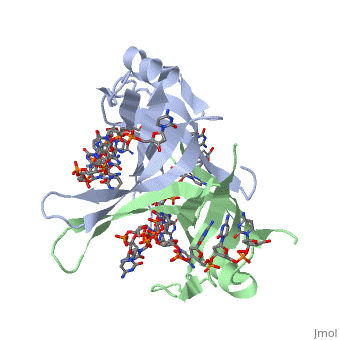Single stranded binding protein
From Proteopedia
Single Stranded DNA-Binding Protein (SSB)
OverviewSingle-stranded DNA-binding protein (SSB) binds to single-stranded regions of DNA. This binding serves a variety of functions - it prevents the strands from hardening too early during replication, it protects the single-stranded DNA from being broken down by nucleases during repair, and it removes the secondary structure of the strands so that other enzymes are able to access them and act effectively upon the strands[1]. Single-stranded DNA (ssDNA) is utilized primarily during the course of major aspects of DNA metabolism such as replication, recombination and repair [2]. In addition to stabilizing ssDNA, SSB proteins also bind to and control the function of many other proteins that are involved in all three of these major DNA metabolic processes. During DNA replication, SSB molecules bind to the newly separated individual DNA strands, keeping the strands separated by holding them in place so that each strand can serve as a template for new DNA synthesis[3]. Structure of E. coli SSBSSB proteins have been identified in many different organisms, but the most well understood SSB remains the SSB of E. coli. E. coli SSB is a homotetramer consisting of which are each about 19 kDa in size [4]. There are two different binding modes of the E. coli SSB when it complexes with ssDNA[5]. Regulation of these modes has been found to be dependent on salt concentration, in addition to other unknown factors. Under low salt conditions, the protein is less efficient as only two of the four identical subunits of E. coli SSB were found to bind to the ssDNA [6]. This is a common theme among DNA binding proteins. The cause is presumed to be that the protein has less ion decoration at lower salt levels. And it could be that the subunits interact with each other through salt bridges to remain close to each other and the DNA. Under high salt concentrations, however, all four subunits of the homotetramer bind to the ssDNA, increasing the number of nucleotides in contact with the SSB and thus favoring SSB-ssDNA interactions. Depending on the salt concentration and other factors, estimates of the size of the site of interaction between SSB and ssDNA range anywhere from 30 to 73 nucleotides for each tetramer [7]. Active E. coli SSB is made of a homotetramer with extensive DNA binding domains that bind to [8]. The tetramers consist of , , and random coils. Each subunit contains an α-helix and several β-sheets. The secondary structure also includes a NH2 terminus, which consists of multiple basic residues, or . The DNA-binding domain lies within 115 amino acid residues from this terminus. The COOH terminus includes many negatively charged, or [9]. Binding Interactions in the Active Sitecan interact with SSB through hydrogen bonds, stacking, or electrostatic interactions. Though SSB proteins are found in a variety of different organisms, most interactions between SSB and ssDNA happen through the common structural motif of an oligosaccharide/oligonucleotide binding site, referred to as the [10]. The OB fold allows SSB to bind preferentially to ssDNA. Each subunit of a SSB has an (the SSB of E. coli thus has , one per each of its ). This fold consists of a that ends in an . Several specific amino acid residues play essential roles in the binding of ssDNA to SSB. is a key residue involved in binding the ssDNA to the protein, as it has been shown to be the site for cross-linking. Tryptophan and Lysine residues are important in binding as well, as evidenced by modification treatments of lysine and tryptophan residues resulting in a complete loss of binding activity for the protein. The two tryptophan residues involved in ssDNA binding are , which were determined by mutagenesis [11]. One more key residue in the binding site, , was determined by site-specific mutagenesis, as when is substituted with Leu it decreases the overall binding affinity for ssDNA. All of these residues are found in a , which is suitable for nucleotide base interactions. Treatments that modified arginine, cysteine, or tyrosine residues had no effect on binding of SSB to DNA, suggesting that these amino acids are not involved in significant interactions of the protein with the ssDNA. Interactions Between E. coli SSB and other ProteinsMost of the molecule loses flexibility after ssDNA binding. However, three phenylalanine residues in the COOH terminal domain remain flexible, even after DNA binding, suggesting that the COOH terminus has something to do with protein binding [12]. An experiment where one of the three Phe residues was changed to Cys resulted in a protein that could not replicate DNA. This replication defect stemming from the lost phenylalanine residue was likely a result of the inability of the altered C-terminal region to bind other proteins necessary for replication [13]. is believed to play an important role in binding the RecA protein. SSB will interact with the protein RecA to enable recombination, because RecA will recognize SSB and replace it on the strand. In DNA repair, SSB will bind to the damaged strand to protect it. And eventually it will attract repair enzymes which will replace SSB and begin repair mechanisms. Mutations in have been shown to have extreme effects on recombinational repair. SSB is also thought to bind with exonuclease I, DNA polymerase II, and a protein n, which is a part of the primosome complex and used to help synthesize RNA primers for the lagging strand [14].
Other SSB Structures
| ||||||||||||||||||||||||
Proteopedia Page Contributors and Editors (what is this?)
Refayat Ahsen, Rachel Craig, Michal Harel, Alexander Berchansky

